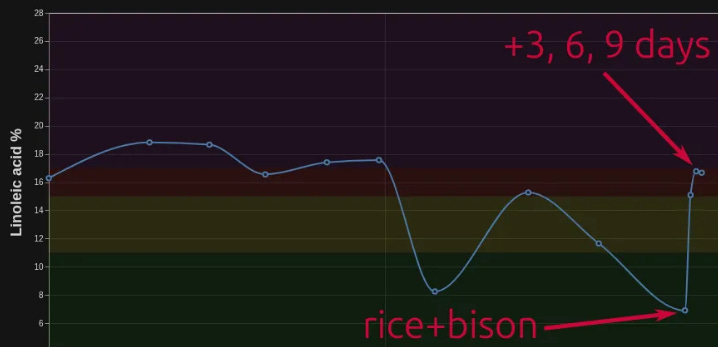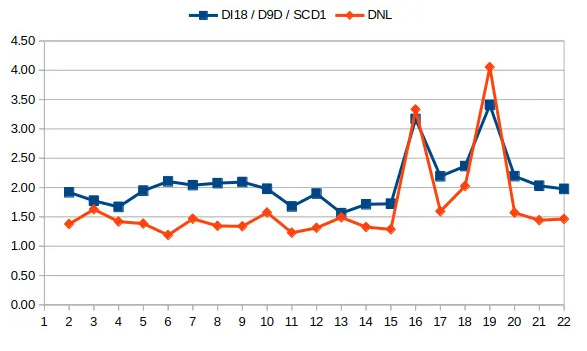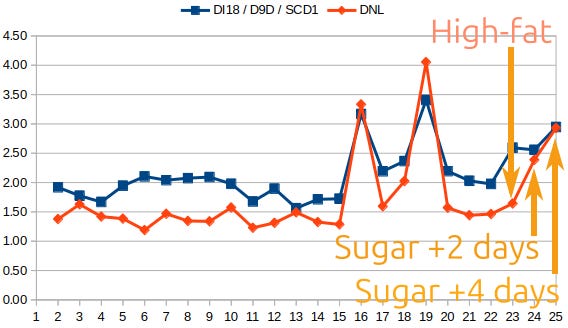DNL ramp-up time
Let's science the s**t out of this
Recap: turning off DNL takes 3-6 days
A month ago I posted about an experiment switching from HCLF (high-carb, low-fat) to HFLC (high-fat, low-carb).
Specifically, I knew that the OmegaQuant Complete values on these 2 diets look pretty different because of DNL (de novo lipogenesis), the process by which the body produces fats endogenously.
On a high-fat diet, there is very little need for DNL: more than enough fat is coming into the system from dietary intake.
But on a very-low fat diet, DNL is massively upregulated.
This is interesting to me for several reasons:
Understanding how the body generates fats from scratch seems relevant to obesity
DNL can massively impact your LA (linoleic acid) reading on the OmegaQuant, e.g I’m around 15-16% LA on a high-fat diet, but have tested 6-8% on a very-low-fat diet. If we want to understand our current linoleic acid levels, it’s therefore pretty relevant to know if we’re in a DNL-heavy context or not.
What last month’s experiment was intended to find out: how long after switching from low-fat to high-fat until DNL stops?
To find out, I took 4 OQCs in a row, with 3 days between them. Before the diet switch, +3 days, +6 days, and +9 days:
As you can see, the LA-suppressing effect of DNL is almost entirely gone at only +3 days. Day 9 is even slightly lower than day 6, so it’s definitely over by day 6.
Here’s 2 ratios from my fatty acids that make it more visible, including the actual DNL (defined as palmitic acid over linoleic acid). Note that in this graph, the X axis isn’t temporal, it’s just evenly spaced out data points - even if the last 4 data points happened in rapid succession every 3 days.
A full switch in ~3-6 days was honestly much faster than I expected.
But what about turning DNL on again?
That’s what this month’s experiment was all about. I decided to go with 2 day intervals this time, since everything seemed to already be over by day 3 last time. Unfortunately you can’t just wing it and go by the live data, because it takes 3-4 weeks between taking an OmegaQuant Complete and getting the results. I therefore had to decide on a testing schedule upfront.
I decided to do 0 days, +2, and + 4 days. The switch this time: going from ex150-14 through a high-fat/high-starch swampy refeed into ex_sugar:
Here we can see that the drop in LA, caused by the upregulation of DNL, is just about as fast: going from 15.17% on the high-fat diet, my LA drops like a rock. Day 2 of the sugar diet it’s already down to 10.24%, and day 4 it is at 8.35%. Unfortunately I didn’t do a day 6 test, it might’ve gone a bit lower, like the 6.9% I’ve tested previously.
But in terms of determining how fast DNL turns off and back on again, this is a good enough test: a handful of days is easily enough.
Here’s that DNL chart with the new data points added:
Interestingly, it looks like the blue line (SCD1) ticked up.. faster or slower than the red one (DNL)? I guess it could’ve ticked up faster in that it was already higher than before on a mixed high-fat/high-starch refeed. Or it was slower in that it might’ve already been sitting there, didn’t react on day 2, and only ticked up on day 4.
The red line, DNL, behaves pretty much like in the last experiment, just in reverse. And since we spaced it out by 2 instead of 3 days this time, we actually get to see one data point roughly in the middle. And since I didn’t do the day 6 test, we don’t see how high it would’ve gone - presumably, to a similarly high level as previously on the rice and rice+bison diets, which are the other 2 red spikes.
So what’s this good for?
I think the main application of this knowledge would be in cycling high-fat and very-low-fat diets. The idea’s been floating around that switching between these two might be a good way of depleting your linoleic acid rapidly.
To cycle, it would be important to know how much time you need to spend in each state: if it takes 2 weeks for DNL to ramp up/down, you should probably do cycles of at least 2 weeks - otherwise, you’re never in the target metabolic context.
But seeing that it takes merely 2-6 days to completely turn DNL off or on, even cycles of 1 week each spent in high-fat/very-low-fat might be useful.
Or maybe the secret to success would be to switch back BEFORE your body has entirely switched metabolic context, i.e. before it can fully rely on DNL? Maybe you need to be tricking your body for this by switching back and forth too rapidly for it to react? We don’t know.
It’s also useful for diagnosing your own DNL state in determining your linoleic acid: when you take your OmegaQuant Complete, you need to account for the last 2-6 days of dieting. Was it a very-low-fat diet? If so, your DNL was likely jacked up, and you can tell by the OQC result. If it was a high-fat diet, you’d expect your DNL to be much lower.
This should give you confidence that you only need to look at the last 2-6 days of dieting before you took the test, not the weeks leading up to it. And, honestly, the first 2-3 days will already reflect the majority of the change.
Unfortunately, we still don’t have The One Formula To Compare Them All: a 10.5% LA is very good on a normal-fat diet, but on very-low-fat diets we’ve seen much lower, as low as 4.9% in lean, near-zero fat fruitarians.
Besides telling you that the 4.9% and the 10.5% can’t really be compared in terms of what adipose level they reflect, I can’t tell you how to turn one into the other, even though we know your DNL activity level from your test..
Following up: yes, my LA dropped again
In last month’s experiment, I had expressed surprise that, after 30 days of HCLF, my LA% had shot back up to 16.6% after previously having dropped to 15.27%. My speculative explanation at the time: while I’d previously seemingly depleted my LA by doing the rice diet, my new low of 15.27% had only been tested nearly 2 months after I finished the rice diet.
Maybe doing a HCLF diet would temporarily spike your LA% on the OmegaQuant, since the newly released LA from adipose tissue got incorporated into red blood cells? If so, we’d expect the LA% to subsequently drop again.
So far, that seems to have come true: testing just before the HCLF switch, I hit another (non-DNL) low of 15.17%. Mind you that’s only 1 month after the rice+bison experiment ended, whereas the last low was measured nearly 2 months after my first rice trial.
Red blood cells live for 3-4 months, so it could be that the number drops a bit more over the next 2-3 months.
This experiment sort of concludes some of the more technical, nerdy questions I had about the OmegaQuant Complete. I therefore don’t have any super crazy/rapid succession OQCs planned for the near future.
I’ll just keep monitoring it once in a while over the next few months or years to see if the linoleic acid keeps slowly dropping.








How low do you think does fat need to be as percent of calories to turn on DNL?
Very nice writeup, right in line with my interpretation of your results.